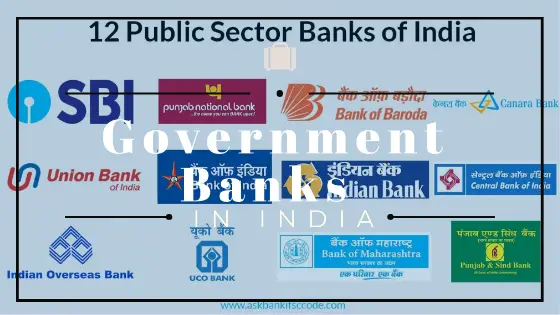Government Banks In India: List Of Names

Banks, like every other country, play an important role in our country’s economy as most transactions take place through the banks. India’s central banking agency and the sole monetary authority is the Reserve Bank of India. There are three types of commercial banks, the State / Government Bank, the Private Sector Bank, and the Foreign Sector Bank. It was no surprise when Finance Minister Nirmala Sitharam announced on 30 August 2019 a series of mergers involving public sector banks.
Government Banks (Banks of the public sector)
These banks have a government interest of more than 50% and there is no differentiation between the Nationalized Bank and the Bank of the Public Sector. They’ve both got the same sense.
The 27 former banks of the government were:
- Allahabad Bank
- Andhra Bank
- Bank of Baroda
- Bank of India
- Bank of Maharashtra
- Canara Bank
- Central Bank of India
- Corporation Bank
- Dena Bank
- Indian Bank
- Indian Overseas Bank
- Oriental Bank of Commerce
- Punjab & Sind Bank
- Punjab National Bank
- Syndicate Bank
- UCO Bank
- Union Bank of India
- United Bank of India
- Vijaya Bank
- IDBI Bank((77.79% government stake)
- SBI+and it’s five associate banks
- Bharatiya Mahila Bank
The number of public sector banks (government banks) has fallen from 27 in 2017 to 12 with the announcement made on 30 August 2019.
The mergers of the Public Sector Banks as announced are
1. Punjab National Bank, Oriental Bank of Commerce, and United Bank (2nd largest Public Sector
Bank)
2. Canara Bank and Syndicate Bank (4th largest Public sector Bank)
3. Union Bank, Andhra Bank, and Corporation bank (5th largest Public Sector Bank)
4. Indian Bank and Allahabad Bank (7th largest Public sector Bank)
12 Public Sector Banks (Government Banks) Existing List
1) The State Bank of India was previously referred to as the Imperial Bank of India and remains India’s largest public sector bank to date. Its headquarters in Mumbai, Maharashtra, was established in 1955. Earnings are INR 2,110 billion. SBI has a presence in 36 other countries, where about 195 + offices have been set up. It was found that SBI has around 59,291 ATMs and 26,340 branches in a survey conducted in the year 2017.
2) Punjab National Bank’s new name of amalgamated 3 is Punjab National Bank, Oriental Bank of Commerce, and United Bank. It is India’s second-largest public-sector bank founded in 1894. The headquarters is in New Delhi, Delhi and its revenue are INR 774.22 billion. PNB ranks # 717 in Forbes Global and # 6 in Forbes Indian banks, and # 26 in Fortune (Indian) 500 as well. PNB has over 7,000 branches and 3,766 ATMs in India and PNB was named the best bank in the public sector in 2012. PNB’s earned USD 8.3 billion as of December 19. On the 1st of April, the United Bank of India and the Oriental Commerce Bank merged into the Punjab National Bank, becoming the second largest bank in the public sector.
3) Bank of Baroda merged with Dena Bank and Vijaya Bank, forming the country’s third-largest public-sector bank through loans. It has its headquarters in Vadodara, Gujarat, and was established in 1908. The revenue it makes is INR 422 billion. Today Baroda Bank has more than 9,500 branches, 13,400 ATMs, 85,000 employees, and serves more than 120 million customers worldwide. Many banks have merged with Bank of Baroda to date, with the companies being incorporated in 1958 just 50 years after they were established.
4) Bank of India was established in 1906. It is a commercial bank that became nationalized with 13 other banks in July 1969. It was founded by the Maharashtra group of eminent businessmen from Mumbai. Hence its headquarters are based in Mumbai, Maharashtra and revenue is INR 418bn. The Bank of India hired 48,807 employees as of 2019. The 5500 branches are operated by 54 zonal offices.
5) Bank of Maharashtra was established in 1935 and was founded by V. G. Kale and D. K. Sathe. It was registered and nationalized in 1969. The headquarters is located in Pune Maharashtra and the revenue is INR 130.53 billion. With the support of more than 1897 branches, they represent millions of clients. Bank of Maharashtra won 102nd place and ranks # 21 among other Indian banks, according to Fortune 500.
6) Union Bank of India, with its headquarters in Mumbai, Maharashtra, was established in 1919. The bank has a network of 2,600 fully automated Core Banking Solution branches and 3,040 Auto Teller Machines. The assets of Union Bank of India total 210 billion dollars. The bank has approximately 4300 branches, a few of which are located overseas, such as Hong Kong, Dubai, Sydney, etc. Rs. 38,17,80,379 in revenue was created by the bank as of March 2019. The bank had about 35,514 employees as of 2016.
7) Canara Bank was established in 1906 and is one of the largest nationalized public sector banks. It was established by Ammembal Subba Rao Paiand in Mangalore and nationalized in 1969. The headquarters are based in Bengaluru, Karnataka and the bank has INR 558.30 billion in revenue. Canara Bank has more than 6,000 branches, and over 9 lakh crores have crossed its sector globally.
8) Central Bank of India was established in 1911. With its headquarters in Mumbai, Maharashtra, it is the oldest and biggest commercial bank. As of 2018, the bank has 4685 branches as well as 4886 ATMs. In the year 2018, it generated revenue of $370 million. It was one of the very first credit card issuing banks. India’s Central Bank has 37,162 workers. It is present in all the Indian states and in 5 of the 6 territories of the Union.
Read more about Indian Government Banks
